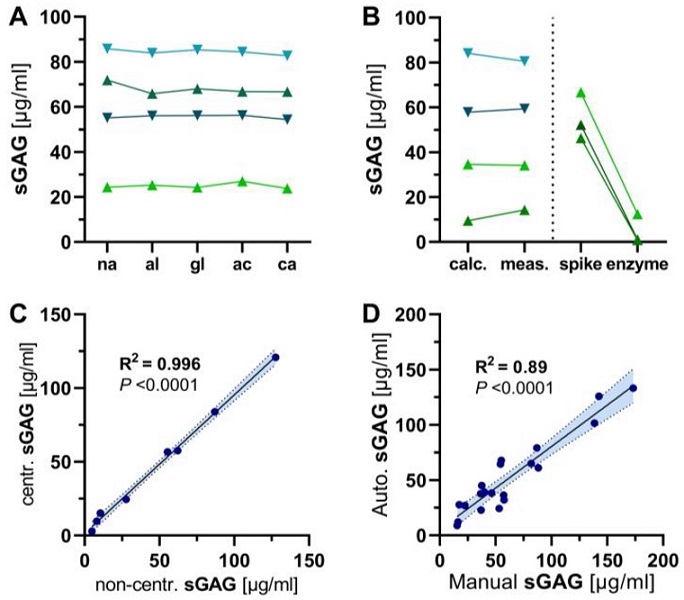German Study Finds Urinary Glycosaminoglycans Can Be Used As Biomarkers To Predict Outcome In COVID-19 And Community-Acquired Pneumonia
Thailand Medical News Team Aug 15, 2023 1 year, 8 months, 1 week, 13 hours, 50 minutes ago
COVID-19 Research: The COVID-19 pandemic has not only challenged global healthcare systems but has also spurred extensive research into understanding the underlying mechanisms and identifying potential biomarkers for disease severity and prognosis. In this pursuit, a groundbreaking study conducted by University Hospital Muenster-Germany, Marienhospital Steinfurt-Germany, Charité-Universitätsmedizin Berlin-Germany, and the German Center for Lung Research (DZL)-Berlin has uncovered a promising avenue for predicting outcomes in COVID-19 and community-acquired pneumonia (CAP) patients.
 Pre-analytics of the DMMB assay using urine samples. (A–D): DMMB assay characterization with urinary samples from septic shock patients and healthy controls. Same samples are coded by same colours. (A) Influence of possible interfering urinary constituents. Native samples (na) of septic shock patients or healthy controls (n = 2 each) were spiked with supra-physiologic concentrations of albumin (al), glucose (gl), acetone (ac) or calcium chloride (ca). (B) Samples were spiked with 62.5 µg/mL Chondroitinsulfate (CS) solution. Calculated concentrations (calc.) of sulfated glycosaminoglycans (sGAG) were compared to concentrations measured with DMMB assay (meas.). Urine samples from healthy subjects (n = 3) were spiked with 250 µg/mL CS solution (spike) and subsequently digested with chondroitinase (enzyme). (C,D) Linear regression with 95% confidence interval between (C) centrifugated and non-centrifugated samples, as well as (D) manual and semi-automatic-operated DMMB assay
Pre-analytics of the DMMB assay using urine samples. (A–D): DMMB assay characterization with urinary samples from septic shock patients and healthy controls. Same samples are coded by same colours. (A) Influence of possible interfering urinary constituents. Native samples (na) of septic shock patients or healthy controls (n = 2 each) were spiked with supra-physiologic concentrations of albumin (al), glucose (gl), acetone (ac) or calcium chloride (ca). (B) Samples were spiked with 62.5 µg/mL Chondroitinsulfate (CS) solution. Calculated concentrations (calc.) of sulfated glycosaminoglycans (sGAG) were compared to concentrations measured with DMMB assay (meas.). Urine samples from healthy subjects (n = 3) were spiked with 250 µg/mL CS solution (spike) and subsequently digested with chondroitinase (enzyme). (C,D) Linear regression with 95% confidence interval between (C) centrifugated and non-centrifugated samples, as well as (D) manual and semi-automatic-operated DMMB assay
COVID-19, caused by the severe acute respiratory syndrome coronavirus 2 (SARS-CoV-2), is now widely recognized as a systemic disease with vascular inflammation and substantial endothelial injury. This vascular impairment is characterized by damage to the endothelial glycocalyx (eGC), a gel-like layer lining the vascular endothelium that plays a vital role in maintaining microcirculatory balance and shielding the endothelium from harm.
Central to this study is the notion that sulphated glycosaminoglycans (sGAGs) are key components of the eGC. The study team postulated that quantifying the amount of sGAG fragments shed in urine could potentially serve as a surrogate marker for systemic eGC damage, thus enabling the prediction of disease severity and outcomes in COVID-19 and CAP patients.
To explore this hypothesis, the
COVID-19 Research team employed an in-house optimized 1,9-dimethylmethylene blue (DMMB) assay to measure total urinary sGAG concentration. This assay was selected for its high accuracy and resistance to interferences, making it a reliable tool for assessing sGAG levels. Notably, the study included a cohort of 67 hospitalized COVID-19 patients and 72 hospitalized CAP patients, allowing for a comprehensive comparison of urinary sGAG concentrations between the two groups.
The results were striking. Urinary sGAG levels were found to be significantly higher in COVID-19 patients when compared to CAP patients. Moreover, both cohorts exhibited a predictive correlation between urinary sGAG concentrations and a combined outcome, encompassing par
ameters such as intubation and death.
This predictive capability was quantified by the area under the receiver operator characteristic curve (AUC-ROC), which reached 0.72 for COVID-19 patients and 0.70 for CAP patients.
These findings hold profound implications for the clinical management of COVID-19 and CAP. The DMMB assay, with its ease of use and cost-effectiveness, emerges as a potential game-changer in risk stratification. By quantifying urinary sGAG levels upon hospital admission, medical professionals could swiftly identify patients at higher risk of severe outcomes, allowing for tailored interventions and more focused care.
The study's significance extends beyond its immediate applications. It sheds light on the intricate interplay between vascular health, endothelial dysfunction, and disease progression.
Notably, the study's observations align with the understanding that COVID-19 induces robust endothelial inflammatory responses, potentially contributing to the higher levels of urinary sGAG seen in COVID-19 patients compared to those with CAP.
However, the study acknowledges certain limitations. The sample sizes of the cohorts were relatively small, and factors such as age, gender, and disease severity were not perfectly matched between groups. Despite these constraints, the study's findings underscore the potential of urinary sGAG as an early indicator of inflammatory endothelial involvement in COVID-19 and CAP.
Additionally, the study suggests avenues for future research. Longitudinal studies, accompanied by measurements of sublingual glycocalyx thickness and circulating glycocalyx components, could provide a comprehensive understanding of the congruence and superiority of various measurement methods. This multi-faceted approach would contribute to refining the predictive power of urinary sGAG concentrations and could potentially be applied to other inflammatory diseases with vascular implications.
In conclusion, the collaborative efforts of the German researchers have uncovered a promising avenue for predicting outcomes in COVID-19 and CAP patients. The study's innovative utilization of the 1,9-dimethylmethylene blue (DMMB) assay to measure urinary sGAG concentrations offers a simple, cost-effective, and robust tool for risk stratification and early intervention.
While further research is needed to fully validate the utility of this biomarker, the study marks a significant step forward in our understanding of vascular health and its implications for severe respiratory illnesses.
The study findings were published in the peer reviewed Journal of Clinical Medicine.
https://www.mdpi.com/2077-0383/12/16/5269
For the latest on
COVID-19 Research, keep on logging to Thailand Medical News.
